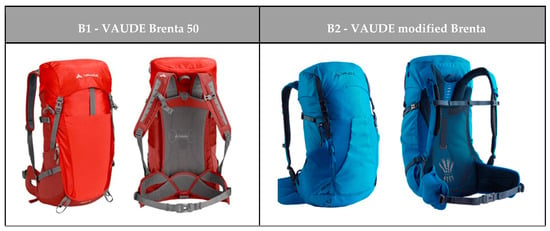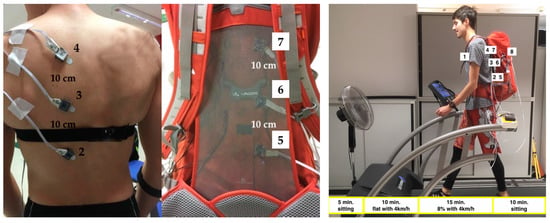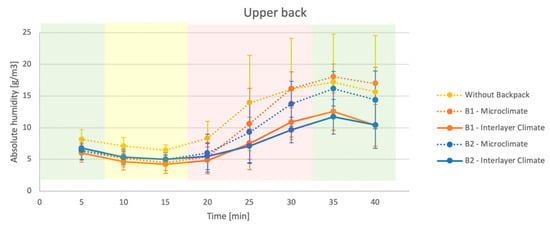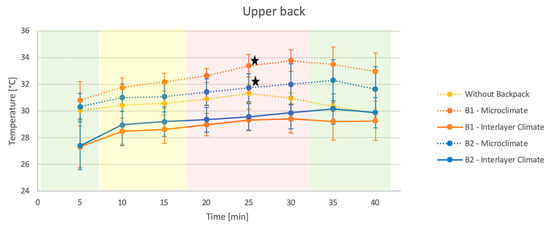Abstract
To assess the thermoregulatory capacities of backpack-designs, five male participants were equipped with a temperature and moisture measuring system. Relative humidity (rH) and temperature (T) were measured underneath the participants’ t-shirt—microclimate (MC)—and between shirt and backpack—interlayer climate (ILC). Participants completed a test protocol simulating a hiking exercise in three conditions in a randomized order: (W) without backpack and (B1-B2) with each of the backpacks (total weight: 5.4 kg). The test-protocol consisted of a 5-min rest, 10-min walk at 4 km/h without gradient, 15-min walk at 4 km/h with 8% incline, and a final 10-min rest. Results showed that the temperature and absolute humidity (aH) values generally decreased from the microclimate to the interlayer climate. Differences of up to ΔT = 1.27 °C and ΔaH = 2.55 g/m3 in the microclimate of the upper back area were observed for different backpack designs, indicating the influence of backpack design on thermoregulation.
1. Introduction
Efficient thermoregulation of the human body is a crucial factor for comfort and performance. Ückert [1] outlined the importance of heat balance stating that it is even more decisive for performance than the amount of red blood cells and therefore should be given more attention in regard of sports. The design of sports clothing and equipment needs to allow for the transport of heat and moisture from the periphery of the body to the environment. For example, during mountaineering, the design of backpacks is essential for the support of the body’s thermoregulation. Previous studies have only used standardized methods under laboratory conditions such as manikins [2] or a stable temperature test arrangement [3] to analyze the water vapor permeability or breathability of one textile. However, there is a lack of research into the interaction of individual layers of clothing between the skin and the environment. This knowledge is fundamentally important for the (further) development of garments and backpacks.
Thermal comfort is a sensory component. In a quote from Clark and Edholm [4], thermal comfort is defined as the absence of discomfort. The concept of comfort varies from person to person. Important variables that influence climate comfort are the level of activity, thermal resistance of clothing, ambient temperature, thermal radiation, relative wind speed and humidity [5].
The human thermoregulatory system is a complex feedback system that is responsible for establishing the equilibrium between heat production and heat loss. Despite internal and external, or personal and non-personal disturbance factors, the system has the ability to maintain body core temperature at approximately 37 °C. To reach this thermal balance, the body utilizes heat generating mechanisms and heat loss mechanisms. A distinction is made between arbitrary (the choice of clothing, posture, muscle work and the temperature control of the surroundings by means of heating or air conditioning), and autonomous thermoregulatory mechanisms (respiration, evaporation, radiation, convection and conduction) [1].
The aim of the study is to determine the microclimate (MC) between the skin and the first layer of clothing, and the interlayer climate (ILC) between the first layer and two backpack designs to draw conclusions about the technical development of backpacks which leads to an optimization of thermal comfort. The main difference between the backpacks is the upper shoulder strap attachment system which has a more open design with an innovative net construction in order to find a right balance between mechanical and thermal comfort.
2. Materials and Methods
For the present study treadmill tests under controlled conditions were carried out with five male recreational athletes with similar training-levels. Their weekly physical activity averaged at 8.6 ± 3.6 h. The average age was 25.6 ± 2.6 years, the mean height 186 ± 5.0 cm and the mean weight valued 73.2 ± 8.3 kg. To reduce the influence of daily variabilities of thermoregulation [6], the measurements for each test person were carried out at the same time of the day (± 30 min) with at least one day of rest in between.
2.1. Materials
To eliminate the influence of different clothing on the measurements, participants wore test T-shirts (VAUDE Men’s Moyle Shirt III; 79% polyester, 15% lyocell and 6% elastane). In addition, the same shorts, socks and shoes were worn for each measurement. The backpack models used were one currently available on the market (B1) and its further developed model (B2) (Figure 1).

Figure 1.
Backpack models. (Left): VAUDE Brenta 50. (Right): further developed Brenta model.
The volumetric capacity of the backpacks (B1 and B2) is 50 L with dimensions of 61 × 33 × 29 cm. The backpacks were loaded with an additional weight (4.1 kg) using PET water bottles together with balloons as filling material (total weight: 5.4 kg). Care was taken to distribute the weight evenly and realistically. Together with the participant the loaded backpack was adjusted and adapted likewise to ensure an optimal and reproducible fit.
2.2. Methods
The developed measurement system included combined T and rH sensors (Si7021, adafruit Industries, New York, NY, USA). To avoid skin-contact, and thus ensure the measurement of the microclimate instead of values of the skin, sensors on the participants’ upper bodies were placed in 3d-printed spacers ensuring a 5 mm air cushion between skin and sensor. Four sensors (4, 3, 2, 1) were attached to the skin (parallel oriented to the skin) with double-sided adhesive dots and sports tape at the anatomical landmarks (Figure 2). The measurement spots on the back had to match the position of the sensors on the backpack sewn behind the rear ventilation (7, 6, 5). Thus, it’s possible to draw conclusions on the thermal comfort of the different parts of the back from both upper shoulder strap attachment systems. The vertical distance between the sensors was 10 cm. Additionally, one sensor (8) was attached on the opposite side of the backpack to measure the ambient temperature and relative humidity. Heart rate was recorded with a Polar pulse watch S625X and a heart-rate chest strap (Polar Electro GmbH, Kempele, Finland).

Figure 2.
(Left): Sensor application on the upper back (4), middle back (3) and lower back (2). (Middle): Sensor application on the backpack. (Right): Whole measurement setup.
The participants completed a test protocol simulating a hiking exercise in three different conditions in randomized order: With B1, B2 and without a backpack (W). A retractable stand fan (Salco GmbH, Weinheim, Germany) generated a headwind of 4 km/h during the 25 min treadmill hike. The height of the fan was adjusted accordingly with the change in gradient. Participant acclimatization was performed by asking them to sit upright on a chair without leaning for 5 min. After that, a 10-min hike on the treadmill at a constant 4 km/h pace was carried out followed by 15 min at 8% incline. For the cool-down phase the last 10 min were recorded in the upright sitting position. In addition to the objective parameters, the subjective sensations were asked every 5 min.
2.3. Data Evaluation
Data were processed with MATLAB_R2017b and analyzed with Excel 2016. The continuously recorded values of temperature and humidity (f = 1 Hz) were condensed into discrete values every 5 min, and mean values with standard deviation were calculated for W, B1 and B2. Absolute humidity was calculated from the relative humidity values. Because of the small sample size, only nonparametric tests were applied (Kruskal–Wallis-H test) to analyze possible significant differences between the test conditions.
3. Results
During the experiments, the ambient temperature was 22.3 ± 0.3 °C, the mean relative humidity 31.25% ± 4.04%.
3.1. Absolute Humidity (aH)
Table 1 displays the absolute and relative increase of aH at all sections of the back from the beginning of the measurement period until 5 min after the end of the exposure phase (35 min). For this duration B2 shows a lower increase of absolute humidity for five of the six sensor positions. The sensor in the ILC at the lower back indicates an absolute increase of 3.86 g/m3 which is slightly higher compared to B1 (3.76 g/m3). This paper will focus on the results of the upper back section in the microclimate (MC) and the interlayer climate (ILC), respectively (Figure 3).

Table 1.
Absolute and relative increase of the absolute humidity at the lower back (LB), middle back (MB) and upper back (UB) in the microclimate (MC) and interlayer climate (ILC) from the beginning until 5 min after the end of the exposure (min. 35).

Figure 3.
Mean values with standard deviation of the aH values at the UB in the MC without backpack (yellow-dotted), with B1 (orange-dotted) and B2 (blue-dotted) as well as in the ILC with B1 (orange-straight) and B2 (blue-straight). Acclimatization (green), walking at v = 4 km/h (yellow), walking at v = 4 km/h and 8% incline (red).
A decrease in aH from the beginning of the measurement period to the end of the walking phase (15 min) can be observed. The increased intensity from 15 min onwards due to the 8% incline, caused a continuous increase in moisture. With the start of the cool-down phase (35 min) a decrease in moisture can be observed. B2 shows the lowest values from the beginning of the exposure until the end of the cool-down. However, the statistical evaluation showed no significant differences between the different backpack models.
3.2. Temperature
The absolute and relative increase of the temperature values from the beginning until the end of the exposure (30 min) are evaluated for all back-sections (Table 2). For four of the six sensor positions, there was less of a temperature increase with B2, except MB-MC and UB-ILC. There was a decrease in aH at the upper back region within the MC, and a lower increase in temperature in B2 compared to B1. (Table 2 and Figure 4). There was a slight rise in temperature for the MC and ILC at the upper back for all three test conditions (W, B1, B2) from the beginning of the exposure (5 to 10 min) to 20–25 min. Measurements without a backpack showed a temperature drop from 25 min onwards. At the same time, the statistical evaluation of the temperatures (B1, B2) showed a significant difference between the backpack models at 25 min in the MC. Both temperatures rose up until 30 min and then decreased slightly noticeable. The ILC shows a continuous increase of the values—on a lower temperature level and with less differences between B1 and B2—from the beginning to the end of the measurement. The evaluation of the subjective sensation did not result in any statistical differences between the backpack models.

Table 2.
Absolute and relative increase of the temperature at the lower back (LB), middle back (MB) and upper back (UB) in the MC and ILC from the beginning until the end of the exposure (30 min).

Figure 4.
Mean values with standard deviation of the temperature at the UB in the MC without backpack (yellow-dotted), with B1 (orange-dotted) and B2 (blue-dotted) as well as in the ILC with B1 (orange-straight) and B2 (blue-straight). Acclimatization (green), walking at v = 4 km/h (yellow), walking at v = 4 km/h and 8% incline (red). ★ significant difference.
4. Discussion
Modifications at the upper shoulder strap attachment system together with an innovative net structure lead to changes in the MC as well as the ILC. Besides previous studies during cycling activities [6,7] this effect could be confirmed for walking. The continuous increase in the aH up to minute 30 or 35 is coupled with a drop in the temperature within the MC due to the cooling effect of the evaporation of sweat. The change of the aggregate state of the sweat droplets from liquid to gaseous state enables the body to release the excess energy in the form of heat [8]. In contrast, the temperature values in the ILC continue rising steadily as heat is transferred from the body to the environment. Switching off the fan at the end of the exposure caused the temperature in the ILC to remain high, because less air could be transferred away from the body [6].
A significant temperature difference could be observed between B1 and B2. The modified backpack model (B2) supports a significantly lower temperature development in the MC at the UB. Considering the results of the aH, B2 often shows a lower humidity than B1. All humidity values in the cool-down phase show a decline in their curves. This indicates that moisture was transferred from the periphery of the body to the environment, and the body adapted to the surrounding conditions.
5. Conclusions
Energy consumption and heat production are increased by external loads and muscle movements, especially when carrying backpacks. Backpacks form an obstacle to heat dissipation and promote heat accumulation. This heat stress can have a negative effect on the user and limit the performance [9]. Thermal discomfort is often strongly related to sweat rates. Knowledge about the regional distribution of moisture is important for the design and technical optimization of backpacks [10]. When it comes to temperature perception a one-degree Celsius variation could be decisive for thermal comfort [11]. The overall aim in the development of new backpacks is to achieve a lower surface temperature of the skin. To succeed, the heat transfer to the environment needs to be accelerated by an efficient air exchange [9]. The contact surface area of the rear ventilation with the body should be designed as small as possible. Thus, an airflow along the spine region should be enhanced where the highest temperature and sweat patterns of the torso are located [12]. However, a compromise must be made between thermal and mechanical comfort in order not to negatively influence the overall wearing comfort for the backpack wearer [9]. The back construction of the prototype (B2) shows promising improvements. The mesh was constructed coarser and less material was used for a better air circulation.
To finally determine significant differences of thermo-physiological parameters for different backpack designs the study must be extended to include more test participants. Furthermore, the thermal comfort regarding sweating distribution and temperature perception is different for males and females [13]. To confirm the better moisture removal, hence the increase of the thermal comfort during hiking activities in general, the study must be complemented with female test participants.
Conflicts of Interest
The authors declare no conflict of interest.
References
- Ückert, S. Temperatur und Sportliche Leistung; Meyer & Meyer Verlag: Aachen, Germany, 2012. [Google Scholar]
- Watson, C.; Nawaz, N.; Troynikov, O. Evaluation of Triathlon Suit Characteristics Relevant to Thermophysiology of an Athlete. In Proceedings of the 12th ISEA, Brisbane, Australia, 26–28 March 2018. [Google Scholar]
- Koptyug, A.; Bäckström, M.; Nilsson, K.; Ainegren, M. Studying Moisture Transport Through “Active” Fabrics Using Humidity-Temperature Sensor Nodes. In Proceedings of the 12th ISEA, Brisbane, Australia, 26–28 March 2018. [Google Scholar]
- Clark, R.; Edholm, O. Man and His Thermal Environment; Arnold: London, UK, 1985. [Google Scholar]
- Fanger, P. Thermal Comfort: Analysis and Applications in Environmental Engineering; Danish Technical Press: Copenhagen, Denmark, 1970. [Google Scholar]
- Weder, M.; Klauer, R.; Michel, F.I.; Breuner, F.; Odenwald, S.; Egli, W. Thermophysiological comfort of cycling backpacks. In Proceedings of the Physiology and Pharmacology of Temperature Regulation—7th International Meeting, Split, Croatia, 7–12 October 2018. [Google Scholar]
- Klauer, R.; Michel, F.I. Thermo-physiological research of micro and interlayer climate during cycling—Influence of two different backpack systems. In Proceedings of the Book of Abstracts of the 23rd Annual Congress of the European College of Sport Science, Dublin, Ireland, 4–7 July 2018; pp. 203–204. [Google Scholar]
- Auer, M. , Michel, F., Harnisch, M.; Sabo, A. Was macht “heiße” Füße im Schuh? Orthopädieschuhtechnik. 2008, 9, 24–29. [Google Scholar]
- Li, Q. C.; Luximon, Y.; Chu, V.H.; Ip, B.M.; Kwan, S.H.; Lau, K.C. An Ergonomic Solution for Ventilating Backpack Design. In Proceedings of the 20th Congress of the International Ergonomics Association, Florence, Italy, 26–30 August 2018. [Google Scholar]
- Fukazawa, T.; Havenith, G. Differences in comfort perception in relation to local and whole body skin wettedness. Eur. J. Appl. Physiol. 2009, 106, 15–24. [Google Scholar] [CrossRef] [PubMed]
- Schmidt, R.; Lang, F.; Heckmann, M. Physiologie des Menschen; Springer Medizin: Heidelberg, Germany, 2010. [Google Scholar]
- Smith, C.J.; Havenith, G. Body mapping of sweating patterns in male athletes in mild exercise-induced hyperthermia. Eur. J. Appl. Physiol. 2011, 111, 1391–1404. [Google Scholar] [CrossRef] [PubMed]
- Havenith, G.; Fogarty, A.; Bartlett, R.; Smith, C.J.; Ventenant, V. Male and female upper body sweat distribution during running measured with technical absorbents. Eur. J. Appl. Physiol. 2008, 104, 245–255. [Google Scholar] [CrossRef] [PubMed]
Publisher’s Note: MDPI stays neutral with regard to jurisdictional claims in published maps and institutional affiliations. |
© 2020 by the authors. Licensee MDPI, Basel, Switzerland. This article is an open access article distributed under the terms and conditions of the Creative Commons Attribution (CC BY) license (https://creativecommons.org/licenses/by/4.0/).